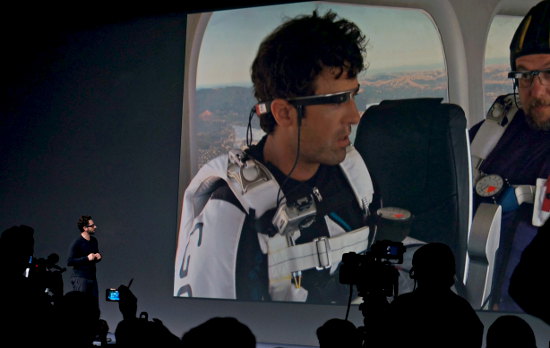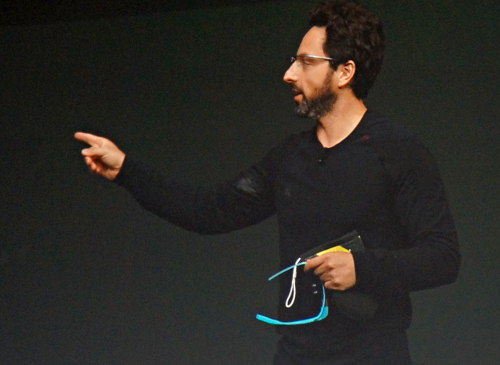Google Wants Help Figuring Out What to do With Its Glasses
A wild eyed, bearded man talking about airships burst on stage during a slow section of the opening keynote at Google’s I/O conference this morning. It was the company’s co-founder Sergey Brin, introducing a stunt to promote Google Glass, eyeglasses with a computer and display built in first demonstrated back in April.

A video link connected Brin with someone in a blimp circling overhead, and to the live view from the Glass prototype they were wearing as they gazed out over downtown San Francisco. When Brin asked for his prototype back, the blimp’s passengers obliged and jumped out of the door. The audience were treated to a live point-of-view feed as they first glided using wingsuits and then parachuted onto the roof of the convention center. One of the Glass prototypes was then whisked away and travelled by bike, abseiling, and bike again to arrive back into Brin’s hands in front of a cheering audience.
Brin then introduced colleagues working on the project who showed a series of touching or amusing photos and videos taken using Glass prototypes. A new mother took photos and videos of her baby on a trip to the park, while another Googler relayed live images of the ceiling from the dentist’s chair. But Brin closed out the demo with a plea to app developers to help come up with uses that go beyond those shown.

“Capturing and sharing images and video is only part of what a wearable computer can do,” he said, “This developer community is going to be key. This is really new technology and we really want all of you to help shape it.” US-based developers that attended the I/O conference this week can now pre-order their own Glass prototype, known as Glass Explorer Edition, for $1500. Brin said they will be sent out in early 2013. “We’re trying to get it out to as many people as we can to get feedback.”
That appeal to developers is a familiar reprise of the model so successfully adopted by Apple for the iPhone. Initially launched without third party apps, the device’s popularity soared once developers could release apps that made creative uses of the gadget. Brin gave no hints about what advice or requirements would be given to developers that got hold of a Glass Explorer Edition, or when a version might be ready for consumers.
Keep Reading
Most Popular
Large language models can do jaw-dropping things. But nobody knows exactly why.
And that's a problem. Figuring it out is one of the biggest scientific puzzles of our time and a crucial step towards controlling more powerful future models.
The problem with plug-in hybrids? Their drivers.
Plug-in hybrids are often sold as a transition to EVs, but new data from Europe shows we’re still underestimating the emissions they produce.
Google DeepMind’s new generative model makes Super Mario–like games from scratch
Genie learns how to control games by watching hours and hours of video. It could help train next-gen robots too.
How scientists traced a mysterious covid case back to six toilets
When wastewater surveillance turns into a hunt for a single infected individual, the ethics get tricky.
Stay connected
Get the latest updates from
MIT Technology Review
Discover special offers, top stories, upcoming events, and more.